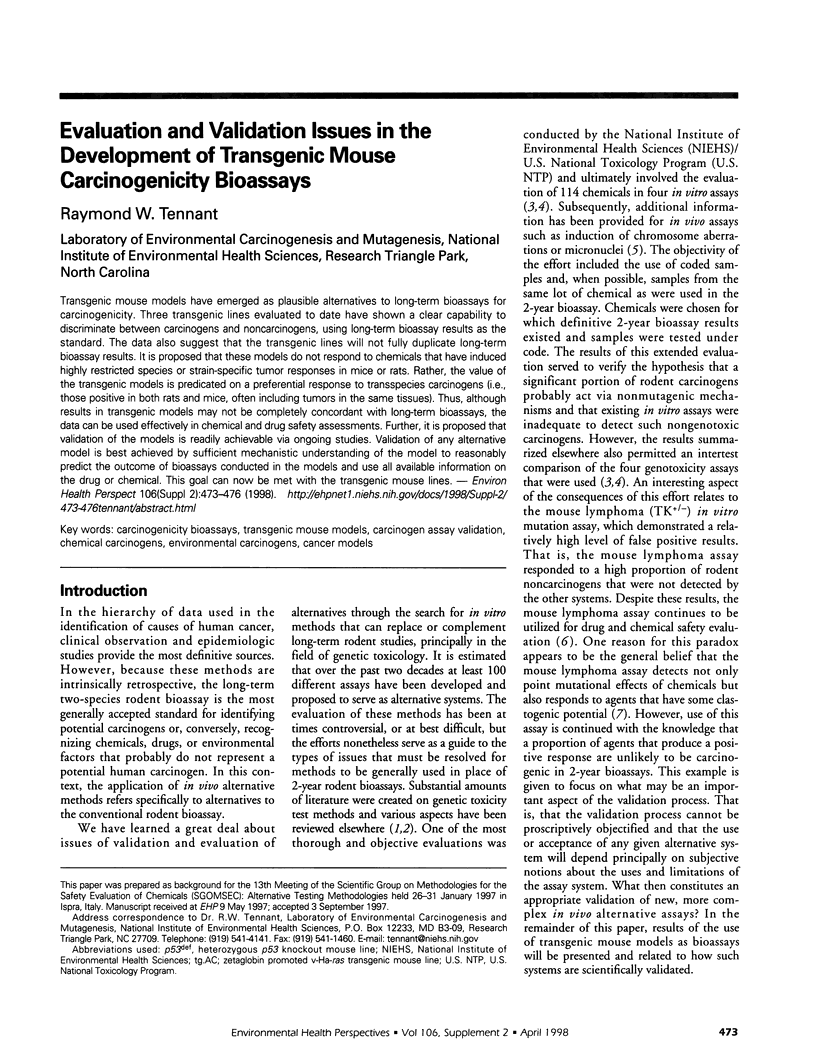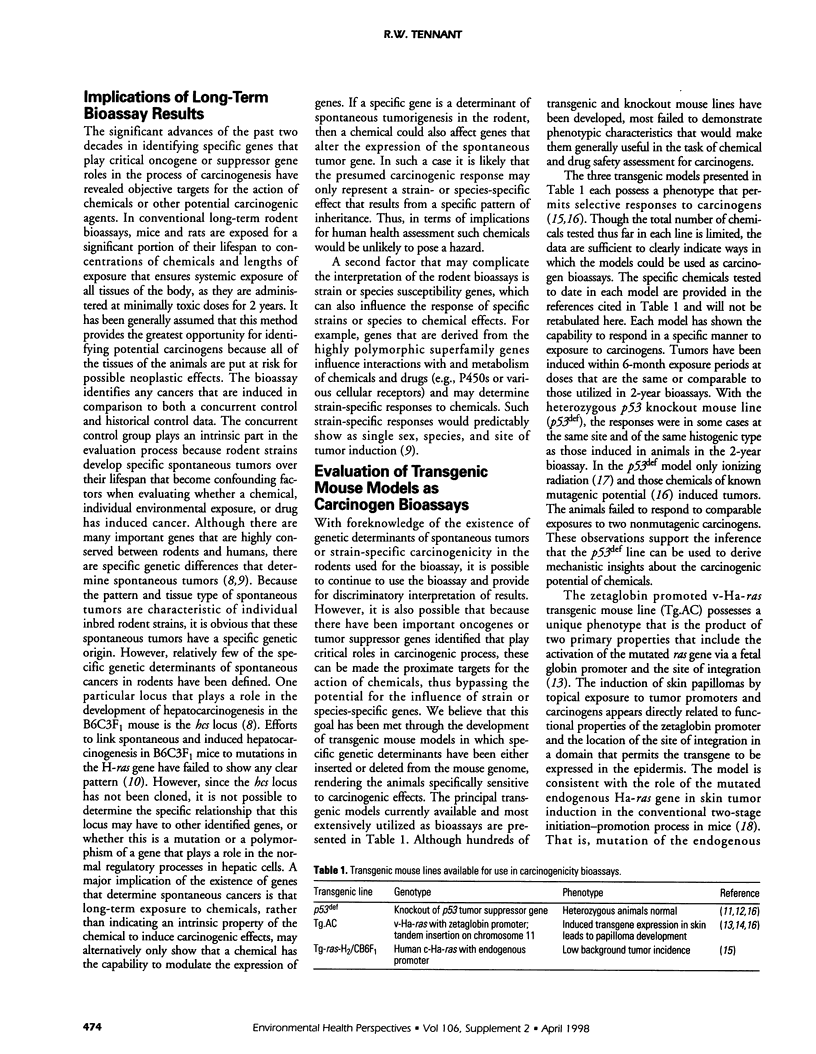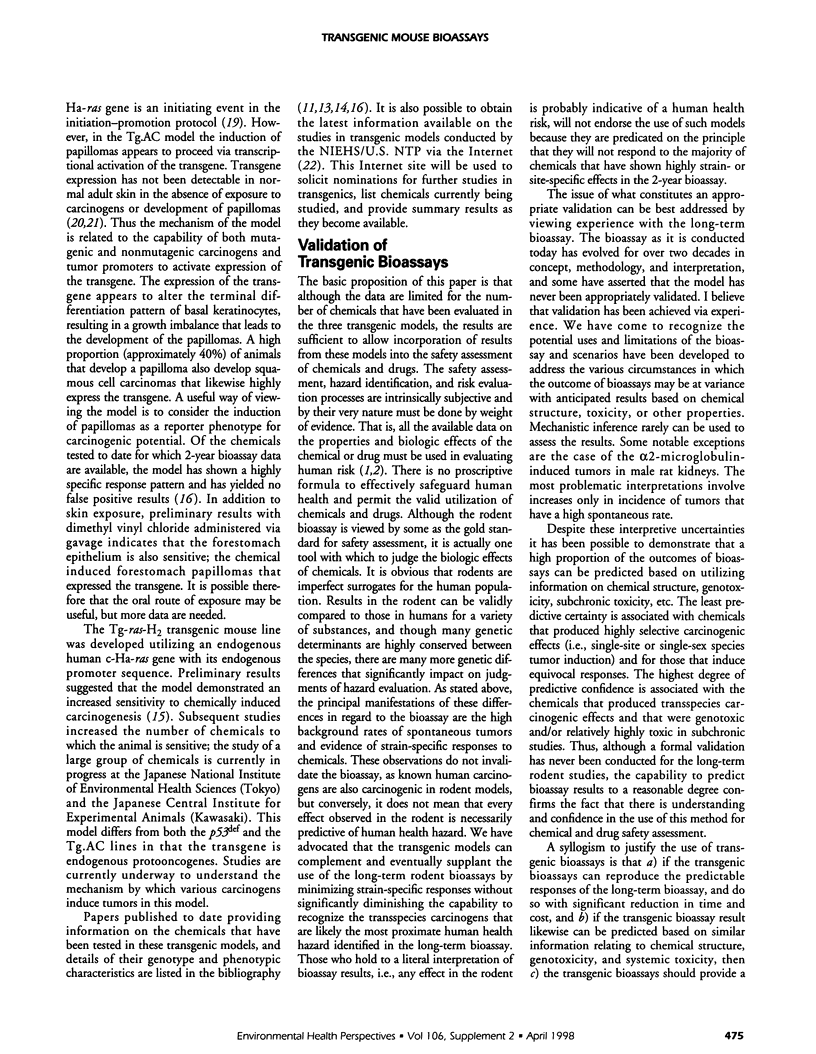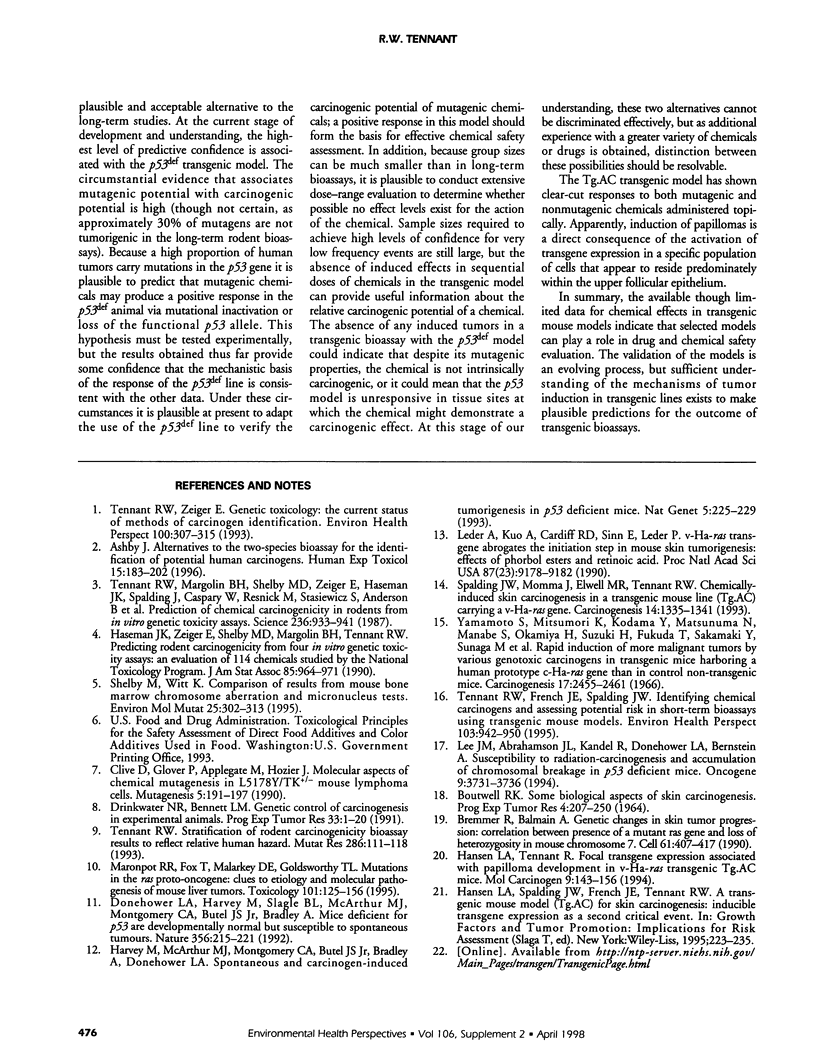Abstract
Transgenic mouse models have emerged as plausible alternatives to long-term bioassays for carcinogenicity. Three transgenic lines evaluated to date have shown a clear capability to discriminate between carcinogens and noncarcinogens, using long-term bioassay results as the standard. The data also suggest that the transgenic lines will not fully duplicate long-term bioassay results. It is proposed that these models do not respond to chemicals that have induced highly restricted species or strain-specific tumor responses in mice or rats. Rather, the value of the transgenic models is predicated on a preferential response to transspecies carcinogens (i.e., those positive in both rats and mice, often including tumors in the same tissues). Thus, although results in transgenic models may not be completely concordant with long-term bioassays, the data can be used effectively in chemical and drug safety assessments. Further, it is proposed that validation of the models is readily achievable via ongoing studies. Validation of any alternative model is best achieved by sufficient mechanistic understanding of the model to reasonably predict the outcome of bioassays conducted in the models and use all available information on the drug or chemical. This goal can now be met with the transgenic mouse lines.
Full text
PDF



Selected References
These references are in PubMed. This may not be the complete list of references from this article.
- Ashby J. Alternatives to the 2-species bioassay for the identification of potential human carcinogens. Hum Exp Toxicol. 1996 Mar;15(3):183–202. doi: 10.1177/096032719601500301. [DOI] [PubMed] [Google Scholar]
- BOUTWELL R. K. SOME BIOLOGICAL ASPECTS OF SKIN CARCINOGENISIS. Prog Exp Tumor Res. 1964;4:207–250. doi: 10.1159/000385978. [DOI] [PubMed] [Google Scholar]
- Bremner R., Balmain A. Genetic changes in skin tumor progression: correlation between presence of a mutant ras gene and loss of heterozygosity on mouse chromosome 7. Cell. 1990 May 4;61(3):407–417. doi: 10.1016/0092-8674(90)90523-h. [DOI] [PubMed] [Google Scholar]
- Clive D., Glover P., Applegate M., Hozier J. Molecular aspects of chemical mutagenesis in L5178Y/tk +/- mouse lymphoma cells. Mutagenesis. 1990 Mar;5(2):191–197. doi: 10.1093/mutage/5.2.191. [DOI] [PubMed] [Google Scholar]
- Donehower L. A., Harvey M., Slagle B. L., McArthur M. J., Montgomery C. A., Jr, Butel J. S., Bradley A. Mice deficient for p53 are developmentally normal but susceptible to spontaneous tumours. Nature. 1992 Mar 19;356(6366):215–221. doi: 10.1038/356215a0. [DOI] [PubMed] [Google Scholar]
- Drinkwater N. R., Bennett L. M. Genetic control of carcinogenesis in experimental animals. Prog Exp Tumor Res. 1991;33:1–20. doi: 10.1159/000419242. [DOI] [PubMed] [Google Scholar]
- Hansen L. A., Spalding J. W., French J. E., Tennant R. W. A transgenic mouse model (TG.AC) for skin carcinogenesis: inducible transgene expression as a second critical event. Prog Clin Biol Res. 1995;391:223–235. [PubMed] [Google Scholar]
- Hansen L. A., Tennant R. Focal transgene expression associated with papilloma development in v-Ha-ras-transgenic TG.AC mice. Mol Carcinog. 1994 Mar;9(3):143–154. doi: 10.1002/mc.2940090306. [DOI] [PubMed] [Google Scholar]
- Harvey M., McArthur M. J., Montgomery C. A., Jr, Butel J. S., Bradley A., Donehower L. A. Spontaneous and carcinogen-induced tumorigenesis in p53-deficient mice. Nat Genet. 1993 Nov;5(3):225–229. doi: 10.1038/ng1193-225. [DOI] [PubMed] [Google Scholar]
- Leder A., Kuo A., Cardiff R. D., Sinn E., Leder P. v-Ha-ras transgene abrogates the initiation step in mouse skin tumorigenesis: effects of phorbol esters and retinoic acid. Proc Natl Acad Sci U S A. 1990 Dec;87(23):9178–9182. doi: 10.1073/pnas.87.23.9178. [DOI] [PMC free article] [PubMed] [Google Scholar]
- Lee J. M., Abrahamson J. L., Kandel R., Donehower L. A., Bernstein A. Susceptibility to radiation-carcinogenesis and accumulation of chromosomal breakage in p53 deficient mice. Oncogene. 1994 Dec;9(12):3731–3736. [PubMed] [Google Scholar]
- Maronpot R. R., Fox T., Malarkey D. E., Goldsworthy T. L. Mutations in the ras proto-oncogene: clues to etiology and molecular pathogenesis of mouse liver tumors. Toxicology. 1995 Aug 25;101(3):125–156. doi: 10.1016/0300-483x(95)03112-s. [DOI] [PubMed] [Google Scholar]
- Shelby M. D., Witt K. L. Comparison of results from mouse bone marrow chromosome aberration and micronucleus tests. Environ Mol Mutagen. 1995;25(4):302–313. doi: 10.1002/em.2850250407. [DOI] [PubMed] [Google Scholar]
- Spalding J. W., Momma J., Elwell M. R., Tennant R. W. Chemically induced skin carcinogenesis in a transgenic mouse line (TG.AC) carrying a v-Ha-ras gene. Carcinogenesis. 1993 Jul;14(7):1335–1341. doi: 10.1093/carcin/14.7.1335. [DOI] [PubMed] [Google Scholar]
- Tennant R. W., French J. E., Spalding J. W. Identifying chemical carcinogens and assessing potential risk in short-term bioassays using transgenic mouse models. Environ Health Perspect. 1995 Oct;103(10):942–950. doi: 10.1289/ehp.95103942. [DOI] [PMC free article] [PubMed] [Google Scholar]
- Tennant R. W., Margolin B. H., Shelby M. D., Zeiger E., Haseman J. K., Spalding J., Caspary W., Resnick M., Stasiewicz S., Anderson B. Prediction of chemical carcinogenicity in rodents from in vitro genetic toxicity assays. Science. 1987 May 22;236(4804):933–941. doi: 10.1126/science.3554512. [DOI] [PubMed] [Google Scholar]
- Tennant R. W. Stratification of rodent carcinogenicity bioassay results to reflect relative human hazard. Mutat Res. 1993 Mar;286(1):111–118. doi: 10.1016/0027-5107(93)90006-2. [DOI] [PubMed] [Google Scholar]
- Tennant R. W., Zeiger E. Genetic toxicology: current status of methods of carcinogen identification. Environ Health Perspect. 1993 Apr;100:307–315. doi: 10.1289/ehp.93100307. [DOI] [PMC free article] [PubMed] [Google Scholar]
- Yamamoto S., Mitsumori K., Kodama Y., Matsunuma N., Manabe S., Okamiya H., Suzuki H., Fukuda T., Sakamaki Y., Sunaga M. Rapid induction of more malignant tumors by various genotoxic carcinogens in transgenic mice harboring a human prototype c-Ha-ras gene than in control non-transgenic mice. Carcinogenesis. 1996 Nov;17(11):2455–2461. doi: 10.1093/carcin/17.11.2455. [DOI] [PubMed] [Google Scholar]


